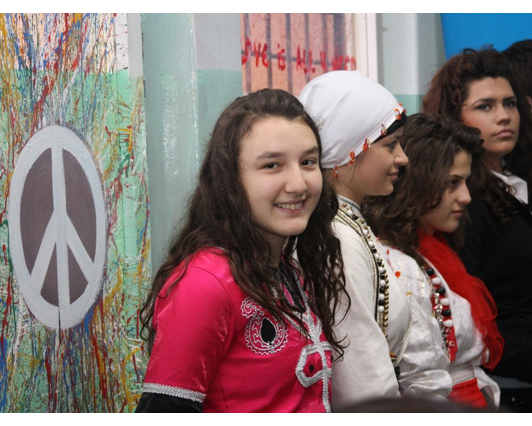

Students in FYR Macedonia build a multi-ethnic future

By Jelena Janevska
“Miredita!” “Dobar den!” “Good afternoon!”
Visitors to the Sande Sterjoski Primary School in Kicevo, FYR Macedonia are greeted in a cacophony of languages as Albanian, Macedonian, Turkish and Roma children cavort in the yard. In a country in which schools and classrooms are increasingly segregated along ethnic lines, Sande Sterjoski is a rare place.
“Its multicultural nature is the greatest treasure of our school”, says school principal Lulzim Mehmedi proudly.
Sande Sterjoski school is one of more than two dozen targeted by a joint UN programme financed by the MDG-Fund to encourage inter-ethnic dialogue and collaboration in FYR Macedonia. Though spared the upheavals of the Yugoslav wars of the early 1990s, Macedonia has experienced growing disparities and polarisation between its many ethnic groups, which is reinforcing stereotypes and perpetuating social tensions.
Breaking down barriers
The UN programme, implemented by UNICEF, works to dissolve boundaries in the ethnically mixed communities of Kumanovo, Kicevo and Struga by having students from different backgrounds attend classes at the same time. These mixed shifts give Macedonian, Albanian, Turkish and Roma youngsters the opportunity to interact during school hours.
Students also jointly take part in after-school, bilingual activities that promote interaction, respect and collaboration. “I love these workshops”, says Marija, a seventh grader. “I meet many new friends from all ethnic groups, learn about their cultures and we do interesting things together”.
The workshops, developed by the Centre for Human Rights and Conflict Resolution, were initially piloted in 12 primary and secondary schools in 2010. They follow a structured methodology and are led by trained teachers and facilitators.
Having seen immediate positive results, the workshops were expanded to 26 other mixed and mono-lingual schools for the 2011/2012 academic year (5 in Kicevo, 13 in Kumanovo and 8 in Struga). The mono-lingual schools are paired with other schools with a different language of instruction. So far, more than 4,000 students have participated in the workshops and 214 school staff from the three municipalities have been trained in how to build trust and understanding across the ethnic divide.
School representatives, local and national government, local NGOs and three UN agencies have all been instrumental in ensuring the success of these activities. Strategies and school action plans have been developed to ensure the programmes continue and to expand them to new schools in the three municipalities.
“Through the extracurricular multicultural activities, students learn new things and socialise with each other. When they leave our school and continue to secondary schools, they are recognised as leaders in the new environment”, says Sande Sterjoski school director Mehmedi.
Building Inter-Ethnic Dialogue and Collaboration
The UN Joint Programme “Enhancing Inter-Ethnic Community Dialogue and Collaboration in FYR Macedonia” is a collaboration between the UNDP, UNICEF, UNESCO and the Macedonian government. It operates with the support of local bodies and civil society in the cities of Kicevo, Kumanovo and Struga.